New Discoveries
 Welcome to the New Discoveries blog! City of San Diego City Clerk Archives staff use this area to upload newly rediscovered documents from San Diego’s history. In their duties, staff often find unique and interesting pieces of history they want to bring to the public. Those documents are uploaded here and then organized into their appropriate Collection, or a new Collection is created. Please check back frequently for fascinating new finds and discoveries!
Welcome to the New Discoveries blog! City of San Diego City Clerk Archives staff use this area to upload newly rediscovered documents from San Diego’s history. In their duties, staff often find unique and interesting pieces of history they want to bring to the public. Those documents are uploaded here and then organized into their appropriate Collection, or a new Collection is created. Please check back frequently for fascinating new finds and discoveries!
Published on
1930-Higher Education

Download Image
Here is an interesting aerial view of San Diego State. It is the oldest and largest higher education institution in San Diego. Founded March 13, 1897, it began as San Diego Normal School, a training facility for elementary school teachers. In 1921, Normal School became San Diego State Teachers College, a four-year public institution. In February 1931, students, faculty, and staff moved into this seven Mission-style buildings surrounding a common area still known as the Main Quad.
Published on
1888 - Elevated Flume at Lake Cuyamaca
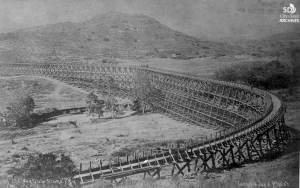
Download Image
Check out this amazing photo of a wooden elevated flume at Lake Cuyamaca, which was set up to provide water for the city of San Diego! Stretching about 37 miles, it was constructed by the San Diego Flume Company between 1886 and 1889. They brought in redwood lumber by boat to the San Diego harbor, cut it to size, and then loaded it onto wagons for the trip inland. Can you believe it? A total of 315 trestles were involved to carry the flume over valleys, canyons, and ravines! The flume's usefulness eventually was replaced with other water sources and today there are very few remnants of the old line remaining.
Published on
1914 - The Historical Balboa Stadium
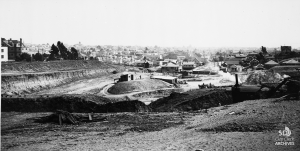
Download Image
If you're a sports fan, you have to take a look at this photo of Balboa Stadium under construction in 1914. It was built for the 1915 Panama-California Exposition, had a capacity of 15,000. Fun fact: it was the home for the San Diego Chargers from 1961 to 1966 before being demolished in the 1970s.
Published on
October 1, 1949- Eye Catching Ads
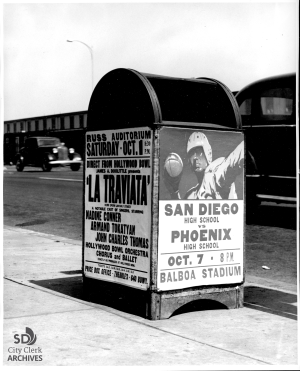
Download Image
Check out these eventful advertisements on a street corner mailbox. La Traviata at Russ Auditorium on October 1 and San Diego vs Phoenix High School Football at Balboa Stadium on October 7, 1949.
Published on
May 25, 1932 – Washington Memorial Tree
On May 25, 1932, the National Society United States Daughters of 1812 dedicated a cedar tree in honor of George Washington, the first President of the United States, in Presidio Park. Members of the organization were very pleased to present the tree to the City of San Diego. Founded in 1892 by Flora Adams Darling and headquartered in Washington, D.C., the National Society United States Daughters of 1812 is a non-profit, non-political, women’s service organization for descendants of American patriots who provided civil, military, or naval service to our country from 1784 to 1815.
Published on
1961- Stellar Customer Service
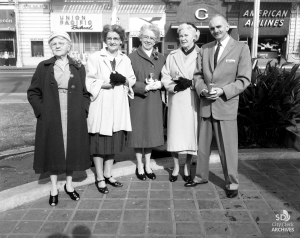
Download Image
Here is a photo of the Horton Plaza Information Booth Volunteers proudly showing off their trophies from 1961. The Information Booth opened on August 22, 1951. The volunteer’s daily task was to answer question and give directions. Such an important part of the community!
Published on
January 1, 1948 - A Pocketful of Roses
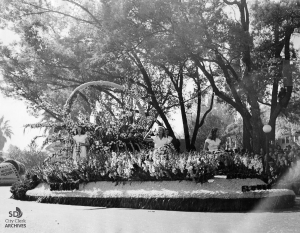
Download Image
Check out this awesome photo of the lovely ladies representing San Diego on their float entry in the 1948 Pasadena Tournament of Roses! The theme of the parade was Holidays in Flowers.
Published on
1939 - Donal Hord and 'Guardian of the Water'
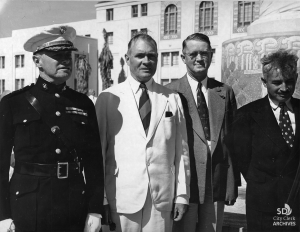
Download Image
Donal Hord (far right) with Mayor Percy Benbough at the dedication of 'Guardian of the Water' Fountain at the County Administration Building. Donal Hord (1902-1966) was San Diego's most famous sculptor. His public art is displayed at numerous locations around San Diego, including Balboa Park and San Diego State University. In 1960, he was commissioned to produce a concrete replica of the statue to give to San Diego's sister city, Yokohama, Japan.
Published on
1937 - Working Women Paving the Way
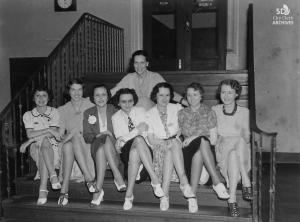
Download Image
Here is an interesting photo of employees who were from the San Diego Chamber of Commerce. The history of the organization dates to the beginning of 1870, when David Felsenheld called a preliminary meeting at his large mercantile house on the corner of F and Sixth Streets. The San Diego Regional Chamber of Commerce was founded later that year by Alonzo Horton with the mission to guide in the development of San Diego.
Published on
1902 - First Public Carnegie Library
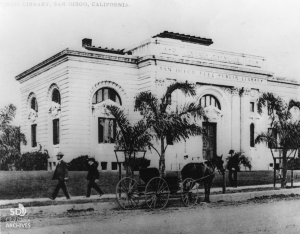
Download Image
Please check out this significant historical photo of first public library in San Diego. In 1897 Lydia Knapp Horton, wife of San Diego founder Alonzo Horton, wrote to Mr. Carnegie to start a funding effort. San Diego had the honor of being the first Carnegie library in California. It opened in 1902 at Eighth and E Streets. It was demolished in 1952 to make way for a new Central Library.
Published on
September 19, 1969 - Reaching Greater Heights
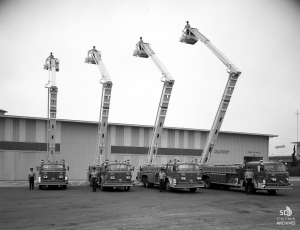
Download Image
Look at this photo of the brave San Diego Firemen standing in extended snorkels of their new fire trucks in 1969. In 1968, the City Council passed a resolution approving the purchase of these Quint 65 Ft. Articulating Arm Aerial Platform Fire Apparatuses for a total cost of $293,012. The American LaFrance Fire Engine Company was one of the oldest fire apparatus manufacturers in America, with roots that go back to approximately 1832.
Published on
July 23, 1948 - San Diego High School Civics Class
We wanted to share this letter from San Diego High School with you. They wanted to express their heartfelt thanks for the warm hospitality their civics class students received at the council meeting on July 20, 1948. Our city always values civic education in schools and loves having students from different schools visit the City Council and Archives throughout the year. Thanks for being a part of it!
Published on
1969 – U.S. Navy Blue Angels
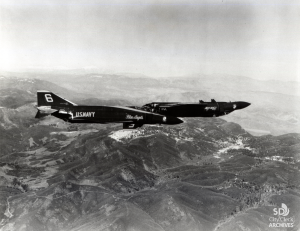
Download Image
Please check out this impressive photo of two McDonnell-Douglas F-4 Phantom jet fighters from the U.S. Navy Blue Angels performing in close formation over Miramar Naval Air Station during the 1969 Air Show. The Blue Angels are known the world over for their precision flying and intricate maneuvers. Noteworthy in this performance for the Blue Angels was the first to fly supersonic jets in back-to-back formation with the top plane inverted and the second snuggled underneath right side up with minimum separation.
Published on
October 19, 1944 – An Appeal from Blood Donor Service
Please review the communication received from the Blood Donor Service, the American Red Cross, San Diego Chapter, dated 1944. Ms. Margaret Price, Director of Blood Donor Service, issued an appeal to City employees to donate blood for our soldiers overseas. World War II concluded one year later.
Published on
March 24, 1938 - Invitation from California Sewage Works Association
Have you seen this pretty invitation letter from the California Sewage Works Association for its 10th Annual Spring Conference held on April 11-12, 1938? Back in the early 20th century, California was really making strides in sewage treatment technology, leading to a notable increase in sewer mileage and sewage treatment plants. As a result, the California Sewage Works Association (CSWA) was founded in 1928. Over the years, it went through several name changes and eventually evolved into the California Water Environment Association (CWEA) that we know today.
Published on
LGBTQ Pride Month - Christine Kehoe
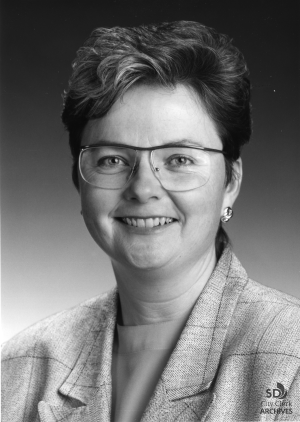
Download Image
Christine Kehoe made history in San Diego in 1993 when she became the city's first openly LGBTQ elected official, serving as Council Member for District 3 until 2000. She went on to be elected to the California State Assembly and later to the California State Senate in 2004. Throughout her tenure in the state legislature, she held the prestigious position of Assembly Speaker pro Tempore - only the second woman to do so.
Published on
August 26, 1964 - Signed Photo of Archie Moore
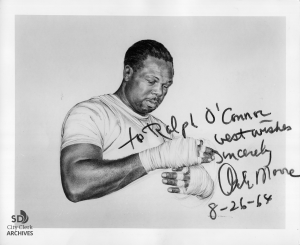
Download Image
Have you seen this awesome signed photo of Archie Moore from 1964? Archie Moore, who was an American professional boxer, is known for being the longest reigning World Light Heavyweight Champion of all time. Fun fact - he's the only boxer to have faced both Rocky Marciano and Muhammad Ali! Born and raised in St. Louis, Moore later adopted San Diego as his home. In 1965, he was honored with the key to the City of San Diego and was also inducted into the Hall of Champions.
Published on
September 5, 1949 - Celebration of Mission Bay Park Opening Day
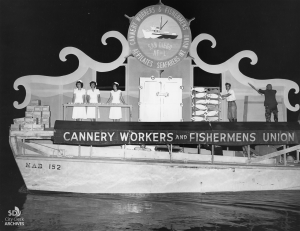
Download Image
Check out this picture of a float decorated by the Cannery Workers and Fishermen Union. The City contracted with the Central Labor Council to stage a water parade consisting of decorated floats on the night of September 5, 1949, as part of the 3-day Fiesta Bahia celebration that officially opened Mission Bay Park. The theme of the parade was 100 years of progress, 1849 - 1949. Other events included entertainment on floating stages and aquatic exhibitions.
Published on
May 12, 1916 – Ordinance Regulating Fish Canneries
In this 1916 document, the Board of Health recommended the adoption of this ordinance regulating fish canneries in the City of San Diego. The first cannery opened in 1909, and San Diego was once known as the “Tuna Capital of the World.” In the 1960s, tuna was the city’s third-largest industry, with almost 40,000 employees.
Published on
August 11, 1890 – Petition from the Ladies Annex
Please take a moment to review this elegantly written petition drafted in 1890 by the Ladies Chapter of the San Diego Chamber of Commerce. The petition proposed the implementation of an ordinance requiring vendors to change from house-to-house produce sales to selling their goods in the market square.

